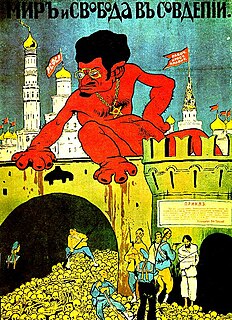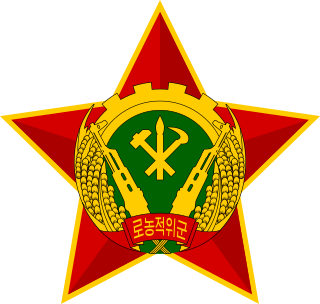Red Guards largely comprised students during China's Cultural Revolution.
Contents
Red Guard(s) or Redguards may also refer to:
Red Guards largely comprised students during China's Cultural Revolution.
Red Guard(s) or Redguards may also refer to:

The Workers' and Peasants' Red Army, often shortened to the Red Army, was the army and air force of the Russian Soviet Federative Socialist Republic and, after 1922, the Union of Soviet Socialist Republics. The army was established in January 1918. The Bolsheviks raised an army to oppose the military confederations of their adversaries during the Russian Civil War. Starting in February 1946, the Red Army, along with the Soviet Navy, embodied the main component of the Soviet Armed Forces; taking the official name of "Soviet Army", until its dissolution in 1991.

A pioneer movement is an organization for children operated by a communist party. Typically children enter into the organization in elementary school and continue until adolescence. The adolescents then typically join the Young Communist League. Prior to the 1990s there was a wide cooperation between pioneer and similar movements of about 30 countries, coordinated by the international organization, International Committee of Children's and Adolescents' Movements, founded in 1958, with headquarters in Budapest, Hungary.

The 3-line rifle M1891, colloquially known in the West as Mosin–Nagant and in Russia and former Soviet Union as Mosin's rifle, is a five-shot, bolt-action, internal magazine–fed military rifle. It is primarily found chambered for its original 7.62×54mmR cartridge.
A Soviet republic, a republic ruled by soviets, may refer to one of the following:

The White movement also known as the Whites, was a loose confederation of anti-communist forces that fought the communist Bolsheviks, also known as the Reds, in the Russian Civil War (1917–1923) and that to a lesser extent continued operating as militarized associations of insurrectionists both outside and within Russian borders in Siberia until roughly World War II (1939–1945). The movement's military arm was the White Army, also known as the White Guard or White Guardsmen.
I Corps, 1st Corps, or First Corps may refer to:
2nd Corps, Second Corps, or II Corps may refer to:

A military parade is a formation of soldiers whose movement is restricted by close-order manoeuvering known as drilling or marching. The military parade is now almost entirely ceremonial, though soldiers from time immemorial up until the late 19th century fought in formation. Massed parades may also hold a role for propaganda purposes, being used to exhibit the apparent military strength of a country.

A red star, five-pointed and filled, is a symbol that has often historically been associated with communist ideology, particularly in combination with the hammer and sickle, but is also used as a purely socialist symbol in the 21st century. It has been widely used in flags, state emblems, monuments, ornaments, and logos.
The Red Army was the army of Soviet Russia (1918–1922) and the Soviet Union (1922–1946)

The Red Guards were the paramilitary units of the Finnish labour movement in the early 1900s. The first Red Guards were established during the 1905 general strike, but disbanded a year later. After the Russian 1917 February revolution the Red Guards were re-established and in the 1918 Finnish Civil War they formed the army of Red Finland. The combined strength of the Red Guard was about 30,000 at the beginning of the Civil War, peaking at between 90,000 and 120,000 during the course of the conflict. The number included more than 2,000 members of the Women's Guards. In May 1918, up to 80,000 Reds were captured by the victorious Whites, 12,000 to 14,000 of them died in the prison camps due to execution, disease and malnutrition. A majority of the Reds were finally pardoned in late 1918.
A temporary capital or a provisional capital is a city or town chosen by a government as an interim base of operations due to some difficulty in retaining or establishing control of a different metropolitan area. The most common circumstances leading to this are either a civil war, where control of the capital is contested, or during an invasion, where the designated capital is taken or threatened.

The Finnish Socialist Workers' Republic (FSWR), more commonly referred to as Red Finland, was a self-proclaimed Finnish socialist state that ruled parts of the country during the Finnish Civil War of 1918. It was outlined on 29 January 1918 by the Finnish People's Delegation, the Reds and Red Guards of the Finnish Social Democratic Party, after the socialist revolution in Finland on 26 January 1918. Its sole prime minister was Kullervo Manner, chairman of the central committee.
The Red Terror was a campaign of mass arrests and executions conducted by the Bolshevik government of Soviet Russia in 1918–1922.

There are a number of reports about the involvement of Chinese detachments in the Russian Revolution and Russian Civil War. Chinese served as bodyguards of Bolshevik functionaries, served in the Cheka, and even formed complete regiments of the Red Army. It has been estimated that there were tens of thousands of Chinese troops in the Red Army, and they were among the few groups of foreigners fighting for the Red Army.
Anti-communism is political and ideological opposition to communism. Organized anti-communism developed after the 1917 October Revolution in the Russian Empire, and it reached global dimensions during the Cold War, when the United States and the Soviet Union engaged in an intense rivalry. Anti-communism has been an element of movements which hold many different political positions, including conservatism, fascism, liberalism, nationalism, social democracy, libertarianism, or the anti-Stalinist left. Anti-communism has also been expressed in philosophy, by several religious groups, and in literature. Some well-known proponents of anti-communism are former communists. Anti-communism has also been prominent among movements resisting communist governance.
White Terror is the name of several episodes of mass violence in history, carried out against socialists, revolutionaries, or other opponents by conservative or nationalist groups. It is sometimes contrasted with, and is the opposite of, a red terror. It may refer to:

The Worker-Peasant Red Guards, also translated as Workers and Peasants' Red Militia (WPRM), is a paramilitary force in North Korea. It is the largest civil defense force in North Korea. It was established on 14 January 1959 by Kim Il-sung and is not only under State Affairs Commission and Ministry of Defense control, but is also attached to the Workers' Party of Korea under its Military Leadership Department. It is thus responsible to the Supreme Leader in his capacity as Supreme Commander of the Armed Forces.

The Revolutions of 1917–1923 was a revolutionary wave that included political unrest and revolts around the world inspired by the success of the Russian Revolution and the disorder created by the aftermath of World War I. The uprisings were mainly socialist or anti-colonial in nature. Some socialist revolts failed to create lasting socialist states. The revolutions had lasting effects in shaping the future European political landscape, with for example the collapse of the German Empire and the abdication of the German Kaiser.
Soviet involvement in regime change entailed both overt and covert actions aimed at altering, replacing, or preserving foreign governments.